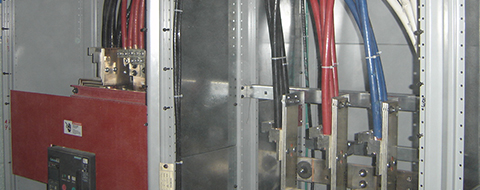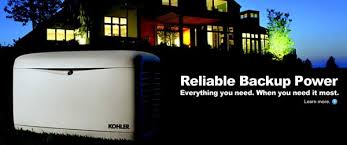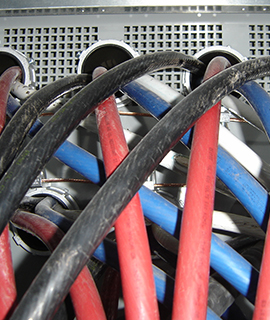Circuit Breaker Tripping Off
A Circuit breaker is designed to trip off when it detects too much power running through the wire it’s protecting. There are three main reasons circuit breakers trip off:

- There is a short circuit.
- There is an overloaded circuit.
- The circuit breaker is broken.
Short Circuits
Short circuits occur when two electrical wires accidentally touch each other. A short circuit will immediately cause one of your circuit breakers to trip off or one of your fuses to blow.
To fix a short circuit ask yourself this question: “What was happening right before the short circuit?” If you had just plugged something into a receptacle (outlet) or turned on a light or an appliance, then this gives you a clue as to what just caused the short.
If you just plugged in an iron, for instance, you can simply un-plug the iron and then re-set the circuit breaker or replace the fuse. If everything is now OK, then your electrical system is fine — and it’s time to get a new iron!
If, however, you can’t find anything plugged in which is causing the problem, then it’s time to call a good electrician to locate and repair your short circuit.
Overloaded Circuit
Overloaded circuits occur when too much power is running through an electrical wire. To protect the wire the circuit breaker does its job by detecting the overload and tripping off. The solution to this problem is to remove some of the things that are connected to the overloaded wires and add another set of wires to bring power to them. For this you’ll need a good electrician.
Broken Circuit Breaker
Sometimes circuit breakers just wear out and need to be replaced. A knowledgeable homeowner with electrical skills can do the job. Otherwise, hire a good electrician.
Refrigerator Power
If the power goes out to your refrigerator or freezer you need to fix it fast! Here are two tips to help you quickly restore power:
- If your refrigerator is plugged into a GFI receptacle, you can re-set the GFI and see if you now have power. If this works, that’s great! Now that it’s working again you should make arrangements to replace the GFI with a regular receptacle as soon as possible.Refrigerators should never be plugged into a GFI receptacle because GFIs are very sensitive, and you don’t want to be on vacation and lose power to your refrigerator just because the GFI accidentally shut off. So if your refrigerator is plugged into a GFI receptacle, you should replace the GFI with a regular receptacle.
- If you can’t restore power to the receptacle that your refrigerator is plugged into, you should call an electrician who is good at troubleshooting to locate and fix the problem. But while you’re waiting for the electrician to arrive, you can plug the refrigerator into a heavy-duty extension cord and plug it in to a receptacle that has power.This will keep your food cold and safe until your electrician arrives.

Dimmers
You might notice that sometimes a dimmer seems warm when you touch it. The good news is, THIS IS NORMAL. Dimmers naturally get warm when they are in use, especially if there is more than one dimmer in the same location.
However, if a dimmer is REALLY warm or hot to the touch, this indicates a safety problem, and you should call an electrician who is knowledgeable about lighting issues.
Dimmer Warning – Two things to be careful about with dimmers:
- Never connect a regular dimmer to low-voltage lights, paddle fans, fluorescent lights, or any kind or motor. These devices require special dimmers.
- Never exceed the recommended wattage of the dimmer. Regular dimmers are rated for a maximum of 600 Watts. This is equal to 10 sixty Watt light bulbs, or 6 one hundred Watt bulbs.NOTE: You can also buy higher-wattage dimmers for connecting more than 600 Watts to one dimmer.
Ground Fault Interrupter’s (GFI)
According to the National Electrical Code, in all kitchens, bathrooms, garages, or any area in which water may be present, instead of regular receptacles, GFI receptacles should be used. These are for your safety.
The idea of a GFI receptacle is that if there is the slightest electrical problem with anything plugged into it, the GFI will immediately shut off the power. This is a great safety feature, and once you unplug the electrical device that caused the problem, you can press the “Reset” button on the GFI to restore power.
When you lose power to a receptacle in a kitchen, bathroom, garage, and outdoor area, check to see if it’s a GFI receptacle. If it is, press the “TEST” button, then press the “RESET” button.
Hint — Sometimes, you may have a receptacle that is located in a kitchen, bathroom, garage, or outdoor area which has no power which is not a GFI. However, even though it looks like a regular receptacle, it can still be “protected” by another GFI that has tripped off somewhere else. The only way to check for this, is to go into your kitchen, bathroom, garage, and outdoor areas to make sure all the GFIs are working properly.
More Technical Data About GFIs
A GFI receptacle (also called a GFCI receptacle) is an electronic device that can measure small differences in power as little as 3ma (which is a very small amount). When it detects more power coming in from the “hot” side than going out from the neutral side, it will shut off. This is a good thing because that extra electricity has to go somewhere, and that might be to you or your family.
All GFI receptacles should be tested monthly. This is done by pressing the “TEST” button. If pressing the “TEST” button does not make the button labeled “RESET” pop out, then call an electrician. If the “RESET” button does pop, the outlet is OK. Press the “RESET” button back in to reset the outlet.
Smoke Detectors
Smoke Detectors are great safety devices, but once in a while a smoke detector will start “chirping” or worse, give out a non-stop alarm for no reason. Here’s a tip on what to do if this happens to you.
If it’s a battery powered smoke detector, take out the battery.
If it’s a 120 Volt powered smoke detector, turn off your circuit breakers one by one until the noise stops.
Then turn on all the circuit breakers again except the one controlling the smoke detector. You will then need to replace the 120 Volt smoke detector or if it is a battery powered smoke detector, replace the battery.
Garbage Disposal Power
If your garbage disposal stops working you should:
- Clear out anything inside the garbage disposal which might be jamming up the motor and stopping it from working.
- Briefly flip on the switch to the garbage disposal. Do you hear a humming noise? If you do, then there is power going to the disposal and the problem is that the disposal is broken or there is something stuck in it.
- If you turn on the switch to the garbage disposal and you do not hear any humming noise, locate the small button that is somewhere on the disposal and press it to “re-set” the disposal. Then try turning on the disposal again.
- Finally, try re-setting all the circuit breakers in your electrical panel to see if you can get power back. To learn how to do this click here, How To Reset Circuit Breakers.If none of this works, it’s time to call a good electrician.
Fuses
When a fuse detects too much power running through a wire, a tiny piece of metal inside the fuse will break, thereby stopping the power from continuing to run through the wire.
When the top of the fuse is made of glass, many people think that they can look at the metal piece inside and see if it is broken. THIS IS NOT ALWAYS TRUE.
The best way to handle a suspected blown fuse is to simply replace it. If the power comes back on, great! If it doesn’t, then you should call an electrician who is good at troubleshooting.
Telephone Power
When power goes out in your home, remember, YOUR CORDLESS PHONE WILL NOT WORK IF THE PHONE’S BASE UNIT HAS NO POWER.
However, if this happens you can still use any telephone that is plugged directly into the wall.
Whole House Surge Protector
 The need for surge protection has increased dramatically. This is because many electronic devices can be damaged by surges. Electronic devices sensitive to power surges occur in security systems, computers, printers, FAX machines, telephones, small appliances, microwave ovens, refrigerators, stereos, garage door openers, and low voltage lighting systems.
The need for surge protection has increased dramatically. This is because many electronic devices can be damaged by surges. Electronic devices sensitive to power surges occur in security systems, computers, printers, FAX machines, telephones, small appliances, microwave ovens, refrigerators, stereos, garage door openers, and low voltage lighting systems.
Anytime there is a power outage, there is the possibility of a power surge upon turning the power back on. Unfortunately, the cost of replacing electronic components can be monumental.
Finally there is a solution to the problem: “whole house” surge protection. Whole house surge protection is now available to the general public at a reasonable cost. Call our In-House Technician and he’ll be glad to discuss whether installing a whole house surge protector would be a good option for you.
Federal Pacific Electric Stab-Lok Service Panels & Breakers
Federal Pacific Electric “Stab-Lok” service panels and breakers are a latent hazard and FPE circuit breakers can fail to trip in response to over-current, leading to electrical fires. The breakers may also fail to shut off internally even if the toggle is switched to “off.” Some double-pole (240-Volt) FPE circuit breakers and single-pole FPE Stab-Lok circuit breakers simply do not work safely.
There are other FPE panel-defects independent of the breaker problems, panel and panel-bus fires and arcing failures in some equipment. The failure rates for these circuit breakers were and still are significant. In some cases failure to trip occurs 60% of the time – a serious fire and electrical shock hazard
Zinsco Panels & Breakers
Zinsco and Zinsco-Sylvania panels and circuit breakers do not offer the level of over-current and fire protection provided by most other electrical panels and circuit breakers. Homes with this equipment may be at greater risk of fire or other electrical hazard.
Limited test result reported by J. Aronstein indicate that the central Zinsco electrical panel and circuit breaker failure problem appears to be burn-ups at the clip-to-bus connection. A circuit breaker whose bus connection burns can lead to overheating damage to the circuit breaker itself, rendering it non-functional.
Energy Savings
 Wasted energy translates into carbon dioxide production, air pollution, acid rain, and lots of money down the drain. The average American household, which spends more than $1,100 per year on energy bills, can often shave 50% off these bills by choosing appliances wisely.
Wasted energy translates into carbon dioxide production, air pollution, acid rain, and lots of money down the drain. The average American household, which spends more than $1,100 per year on energy bills, can often shave 50% off these bills by choosing appliances wisely.
For example, simply replacing a 20-year-old refrigerator with a new energy-efficient model will save you about $85 per year in electric bills and reduce your home’s carbon dioxide contribution by about a ton per year (which reduces global warming).
While energy efficient appliances may be slightly more expensive, the extra up-front cost will be paid back through reduced energy bills long before the product wears out.
The American Council For An Energy Efficient Economy is a non-profit organization dedicated to advancing energy efficiency as a means of promoting economic development and environmental protection. Every year they publish The Consumer Guide to Home Energy Savings, an invaluable guide listing the most efficient energy use.
For more information on energy efficient living you can explore the following websites:
